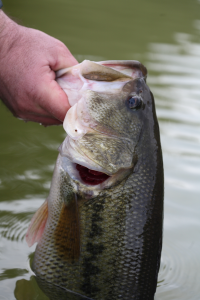
Photo: Kentucky Department Fish And Wildlife
The length of day relative to the time of year never changes. As the nights lengthen slightly with each passing day in fall, the overnight temperatures drop and pull heat from the top layers of lakes.
This development is already underway, but will peak over the next month and make excellent fishing conditions for black bass.
“The cooler, oxygenated water in the shallows draws baitfish and the bass follow to feed heavily,” said Jeff Ross, assistant director of fisheries for the Kentucky Department of Fish and Wildlife Resources. “The shorter days signal to bass that winter is coming and they must feed heavily in fall.”
The shallow movement of black bass, mainly largemouth bass, but a few spotted bass and even smallmouth on lakes that have them, presents the best bass fishing opportunities of the year for bank-bound anglers.
Water temperatures in Kentucky’s major reservoirs are in the mid-70s. When the temperatures drop into the 60s, bank anglers should hit the lower 1/3 of the main lake or major creek arm of our major reservoirs and the dam area of our smaller, state-owned lakes. You will have as good a chance at a 5-pound or better bass as someone with a bass boat that costs as much as many people’s homes.
Bank fishing, like wade fishing streams, returns anglers to a time when all they had was a small, one-tray tackle box and a Zebco 33 combo. You can concentrate on fishing, not fighting wind with a trolling motor or fiddling with a cranky sonar unit. You can bring one rod and one small tackle bag or box and have all you need.
Map study is paramount for finding productive spots to bank fish for bass in fall. Points with the old river or major creek channel running close to them are tops. Most of our major reservoirs have boat ramps and recreational areas in the lower areas of the main lake or a major creek arm that offer public bank access.
Our smaller, state-owned lakes have a 50-foot easement for the public to access the bank for fishing. Visit the Kentucky Fish and Wildlife website at www.fw.ky.gov and click on the “Find a Place To Fish” tab. Many of the state-owned lakes now have 5-foot contour maps and locations of fish attractors featured on this helpful web page.
“You can use a more active bait in fall, especially if you are fishing from the bank,” Ross said. “Crankbaits and spinnerbaits work well in fall. You don’t have to slow things down too much. When they are up shallow, they are pretty active.”
Medium-running crankbaits in shad-colors such as chrome and black work wonders as do white spinnerbaits with skirts of black, silver with touches of blue. “Keep moving and cover water,” Ross said. “You don’t have to be too fancy, just get the bait in front of the bass.”
You will catch mainly largemouth bass, but in the lower sections of lakes such as Lake Cumberland, Barren River Lake or Green River Lake that hold smallmouths, a marauding bronzeback may savage your lure, especially on overcast days. You may also pick up a football-shaped spotted bass. Spotted bass make excellent table fare. It generally benefits the black bass population in the lake if you harvest some spotted bass, one of the reasons they have no minimum size limit.
Boat ramps are another spot to catch bass, especially largemouths and spotted bass. Nearly all boat ramps have a gouge hole at the end of them from the blast of outboards scouring the bottom when trailering a boat. By mid-October, boat ramps get little action from boats, so working a crankbait over the gouge hole at the end of the ramp can produce fantastic action.
The riprap rock that armors the face of most reservoir dams also draws baitfish and bass in fall. “Dams hold those bass when they come shallow in fall and make really good fishing spots for bank anglers,” Ross said.
Crankbaits and spinnerbaits work well for fishing the dam riprap, but a large crappie minnow or small to medium shiner hooked through upper lip with a 1/0-circle hook and a couple of BB-sized split shot weights usually outfishes everything. Keep the outfit moving slowly to avoid hanging the split shot weights in the riprap. Bottom fishing live bait off channel points also works wonders in fall.
Fall is a delightful time to grab a rod, a small tackle bag and hit the bank. The weather is comfortable and the fish hungry.
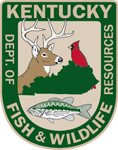 The Kentucky Fish and Wildlife Commission unanimously recommended today that the department increase prices for some resident Kentucky hunting and fishing licenses.
The Kentucky Fish and Wildlife Commission unanimously recommended today that the department increase prices for some resident Kentucky hunting and fishing licenses.
The Commission is the guiding body for the Kentucky Department of Fish and Wildlife Resources. It took the action during its September quarterly meeting. It will be the first resident license price increase in more than a decade, and the first increase of the senior and disabled sportsman’s licenses since their inceptions in 1999.
The Commission recommends all hunting, fishing and boating regulations for approval by the General Assembly and approves all expenditures by Kentucky Fish and Wildlife. All recommendations must be approved by legislators before they become law.
Kentucky Fish and Wildlife relies primarily on license sales and federal excise taxes from the sale of hunting and fishing equipment for its revenue. It does not receive state General Fund money, such as those derived from income taxes or property taxes. The Department manages more than 600,000 acres for public use and stocks nearly 10 million fish each year. Hunting, fishing, boating and wildlife watching generate an estimated $5.9 billion to Kentucky’s economy each year.
The Commission’s recommendation includes resident hunting licenses, fishing licenses, combination hunting/fishing licenses, senior and disabled sportsman’s licenses and joint fishing licenses for spouses.
“Periodic license price increases are necessary to keep pace with inflation and general costs of living,” said Commission Chairman Jimmy Bevins. “We usually project that an increase will last five years, but solid fiscal management historically has allowed us to make them last much longer.”
The Department’s last three resident rate changes happened in 1992, 1999 and 2007. License and permit fees for non-residents increased to help offset rising operational costs in 2014, but resident fees remained unchanged at the time.
Commission members said they took the action to help offset the rising costs of operating the Department’s three summer camps and the Salato Wildlife Education Center. In addition, increased revenue also will be utilized for increased conservation law enforcement efforts across the Commonwealth.
The three summer camps annually graduate more than 5,000 youth. The Salato Wildlife Education Center, located on the main Kentucky Fish and Wildlife campus, hosts more than 50,000 visitors each year.
“These programs are one main reason why Kentucky continues to see robust participation in hunting and fishing despite decreases seen in surrounding states,” said Kentucky Fish and Wildlife Commissioner Gregory K. Johnson. “Our children are our future sportsmen and sportswomen, and our future leaders.
“These license increases help the Department maintain a commitment and solid investment in outdoor education of our youth,” said Johnson. “Revenue also will support a more complete law enforcement presence across the state, and improved law enforcement recruitment and retention.”
“We operate almost entirely from user fees derived from hunting and fishing license sales, and federal excise taxes generated by the sale of hunting, fishing and shooting equipment and ammunition,” said Bevins. “Other Kentucky state agencies are largely funded by General Fund tax dollars.”
“The new rates for residents would not happen until the 2018 license year,” said Bevins, “so that means we will have made our last increase last for 11 years – more than twice the original projection.”
The Commission voted to increase a resident hunting license from its current $20 to $27, a resident fishing license from $20 to $23, a combination resident hunting/fishing license from $30 to $42 and the resident joint fishing license for spouses from $36 to $42.
Currently, the senior and disabled sportsman’s licenses provide $165 worth of licenses and permits for $5. A resident sportsman’s license cost $95.
Under the Commission action, the senior and disabled sportsman’s licenses would increase to $18. In 2007, Kentucky sold 90,184 of these licenses. Kentucky’s aging society caused that number to reach 120,426 by 2016, with that number projected to continue increasing.
“We surveyed senior and disabled license holders across Kentucky and had a strong response,” said Bevins. “Nearly three quarters said they would continue to purchase a license even if it was as much as $20.
“I believe the support from our seniors is a direct reflection of their own memories and experiences,” he said. “They remember when all deer hunting in Kentucky was prohibited prior to 1956 because there were very few deer, and when there were no wild turkey, elk or bears, or fish hatcheries to raise and stock fish.
“Today our fish and wildlife populations are healthy and abundant, and our management program is a national model. Our seniors know better than most that our conservation camps and school programs are helping to leave a better natural Kentucky for their children and grandchildren,” Bevins said.
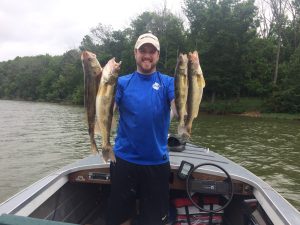
Photo: Kentucky Department Fish and Wildlife
Two employees of the Kentucky Department of Fish and Wildlife Resources recently used the department’s website at www.fw.ky.gov to glean information on catching saugeye.
They used the 5-foot contour maps on the “Find a Place to Fish” to study the bottom of Guist Creek Lake in Shelby County and determine a place to fish. They later fished those areas and caught their first saugeye.
“We trying to provide information on our website to make it easier for anglers to find places to fish and be successful,” said Mike Hardin, assistant director of fisheries for Kentucky Fish and Wildlife. “The “Find a Place to Fish” page allows anglers to sort by county, city, waterbody, access type or even species of fish.”
Many of the waterbodies detailed in the “Find a Place to Fish” page contain important fishing information, such as the 5-foot contour maps. “When you pull these waterbodies up, many of them have the location of fish attractors, species assessments as well as the contour maps. We have the contour maps for most of our smaller state-owned lakes as well as the Fishing in Neighborhoods (FINs) lakes.”
Hardin said the large reservoirs operated by the U.S. Army Corps of Engineers have commercially available maps at tackle shops near the lakes or for sale online. Many of the large outfitters also sell these maps.
“Each entry contains driving directions to all of the ramps on that waterbody,” Hardin said. “They also contain a link to the Fishing Forecast, detailing the fishing for many species in waterbodies across the state.”
Planning a float trip on a stream can be daunting. The “Canoeing and Kayaking” page contains loads of information to help select a place to paddle. You may click on the “Stream Fisheries” tab for detailed information on access sites, lengths of floats and recommended floating levels for streams across Kentucky.
This page also contains photos of each access point and a description of the access. This is invaluable information to paddlers floating a stream for the first time. This page also shows the abundance and size structure of the population of the desirable fish in the stream such as rock bass or smallmouth bass.
The “Canoeing and Kayaking” page also contains a link to the award winning Blue Water Trails series of articles detailing more than 30 different floats across Kentucky. These articles also contain fishing tips for the species in the waterbody as well as a printable map.
“If you are trying to figure out a place for the coming weekend, our website has many resources to help guide you,” Hardin said. “We want people to enjoy our water resources and catch some fish.”

Photo: Kentucky Department Fish and Wildlife
With every passing season, anglers are building their knowledge base about how to catch saugeye stocked in a handful of central and northern Kentucky lakes.
A saugeye is a fast-growing cross between a walleye and sauger that can reach 15 to 19 inches in its second year. The hybridization is evident in the species’ physical appearance. Saugeye display the faint saddle markings of a sauger and the white fin tips of a walleye. Unlike either, it features black smudges on its dorsal fin.
Three lakes – 317-acre Guist Creek Lake in Shelby County, 148-acre Bullock Pen Lake in Owen County and 175-acre A.J. Jolly Lake in Campbell County – received experimental stockings of the species in 2013 and five have been stocked this year by the Kentucky Department of Fish and Wildlife Resources.
Guist Creek Lake received more than 15,000 fingerlings this spring. Anglers have reported good success in recent weeks fishing jigs off mud flats in 4 to 10 feet of water.
Paul Wilkes and Dane Balsman had never tried fishing for saugeye before they visited Guist Creek Lake one day in late June. They spoke with other anglers and studied bottom contour maps available on Kentucky Fish and Wildlife’s website at fw.ky.gov beforehand.
“We were able to identify some flats that we wanted to hit and then went out and graphed some baitfish near the drop-offs of those flats,” said Wilkes, fisheries program coordinator with Kentucky Fish and Wildlife. “We went out there with a mindset of if we caught one or two we were going to be pumped because this was a new species for us.”
The two reeled in 11 saugeye, including one that weighed 4.5 pounds and two others that weighed better than 3 pounds.
“We went out there and tried it and tried a few different drop-offs we mapped,” Wilkes said. “We stuck to the basics of jigging slowly in the areas we had identified. Strikes were kind of a thud, where you almost thought you were hung up until you really pulled it in. Once we found the fish, it seemed like they were in small schools. You’d catch several.”
Minnow or worm-tipped jigs or small shad-imitating crankbaits are good options for saugeye, as are small suspending jerkbaits or swimbaits in grey and white. Wilkes and Balsman, urban fisheries program coordinator with Kentucky Fish and Wildlife, found bladed jig heads with chartreuse bodies worked best for them.
Mike Hardin enjoyed similarly good fortune on Guist Creek Lake this spring fishing a little deeper in 8 to 10 feet of water.
“If you look at the fishing reports from saugeye lakes in Kentucky and Ohio, you see a lot of reports of anglers finding them in shallow water on crankbaits,” said Hardin, assistant Fisheries Division director with Kentucky Fish and Wildlife. “For a long time, I looked and looked and fished extremely shallow water jigging and picking up the occasional saugeye.
“We pulled off the bank and found wads of baitfish in 8- to 10-feet of water and it was game on. Fish close to the bottom, just like walleye fishing.”
He’s also had caught saugeye on Taylorsville Lake. Fisheries biologists believe good saugeye fishing could be in the cards this fall on Salt River above Taylorsville Lake based on population sampling from last fall.
“It seemed like there was definitely a push up there in the river. There’s going to be crappie and saugeye and bass, a little bit of everything,” said David Baker, Central Fisheries District biologist with Kentucky Fish and Wildlife. “Honestly, I think we’re going to be getting a lot of phone calls about saugeye in Taylorsville here in the next year or two.”
This year, the Kentucky Department of Fish and Wildlife Resources stocked more than 150,000 fingerlings in five lakes with Taylorsville Lake receiving more than 115,000 saugeye fingerlings.
Also receiving saugeye fingerlings were Guist Creek Lake, 92-acre Boltz Lake in Grant County and A.J. Jolly Lake in Campbell County. Lake Carnico, a 114-acre lake in Nicholas County, received its first saugeye stocking this year.
“It was a ton of fun and we were able to get on some really nice fish,” Wilkes said. “It definitely exceeded our expectations.”
For more information about saugeye fishing in Kentucky, including special regulations, consult the current Kentucky Fishing and Boating Guide. It is available online at fw.ky.gov and wherever licenses are sold.
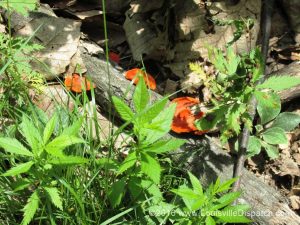 Jefferson Memorial Forest will connect with thousands of other campers and the great outdoors on Saturday, June 24 and Sunday, June 25, as they host the annual Great American Campout.
Jefferson Memorial Forest will connect with thousands of other campers and the great outdoors on Saturday, June 24 and Sunday, June 25, as they host the annual Great American Campout.
The Great American Campout, in its 13th year, is a great way for friends, families, and children experience nature, sleep under the stars and create lasting family memories. Jefferson Memorial Forest will provide the campfire, story-telling, and night hikes; you provide your dinner, breakfast, and tent.
In the morning campers will have the day to explore the Forest by hiking any of our 35 miles of trails, fishing at Tom Wallace Lake with free fishing poles provided at the Welcome Center, or unleashing your adventurous side by taking on the GoApe tree-top adventure course (reservations with GoApe required).
The price of the campout is $25 per family of (4), and $5 each additional family member. Platform tents are available to rent at a cost of $15.
Pre-registration is required by calling the Forest’s Welcome Center at (502) 368-5404.
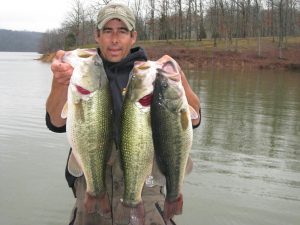
Photo: Kentucky Department Fish and Wildlife
June is one of the best months for outside activities such as fishing. However, many predator species, such as largemouth bass, have already completed their annual reproductive ritual and kind of sulk through June.
It can be a tough month for fishing in lakes and reservoirs, but two options will produce fishing that compares to the marvelous weather.
Largemouth bass in farm ponds:
June is a transitional month for largemouth bass in our larger lakes, but the confined nature of a farm pond ups the odds in the angler’s favor.
“You can catch largemouth bass all summer in a farm pond,” said Jeff Ross, assistant director of fisheries for the Kentucky Department of Fish and Wildlife Resources.
Successful summer largemouth bass fishing in farm ponds is all about timing and changing approaches as the day progresses. Wake up early enough that dew soaks your shoes as you walk to the pond.
Old school topwater lures such as the Hula Popper or a Jitterbug in the bullfrog color draw vicious strikes when slowly worked along the edge of vegetation in the low light of early morning.
As the sun rises, switch to fishing a weightless 7-inch ribbon-tailed worm in the junebug color. “Bass hold tight to cover during the middle of the day on a farm pond,” Ross said. “Fish the shady side of the pond if there is one.”
The weightless ribbon-tailed worm slowly falls through the cover attracting largemouth bass snuggled deeply in it. If the pond has no cover, fish the worm slowly along any weedlines or under any floating vegetation.
As day fades into night, the topwater bite again comes into play. Anglers also catch many farm pond bass in the dark on a 1/4-ounce black spinnerbait with a round Colorado blade.
Fish the spinnerbait just above bottom and let the Colorado blade thump. Hold on tight as largemouth bass often savage this presentation.
Channel catfish:
Channel catfish spawn in Kentucky mainly in June. “They are cavity spawners,” Ross said. “You often find them near riprap or chunk rock.”
Riprap consists of cantaloupe-sized rock used to protect the face of dams, bridge abutments and marinas from erosion caused by the pounding of waves. A 3/8-ounce slip-sinker rig with a 4/0 circle hook is a good choice for catfish when fished on or near riprap or areas of chunk rock lining the banks.
A slip-sinker rig consists of an 18-inch fluorocarbon or monofilament leader with the circle hook on one end. Tie the other end of the leader to a barrel swivel. After threading the main line coming from your rod through an egg sinker followed by a glass bead, tie the main line to the open loop of the barrel swivel.
A circle hook prevents gut hooking catfish. Resist the temptation to set the hook, simply reel in slack line until you feel the catfish swimming and keep your rod tip high. The catfish will hook itself in the side of the mouth with a circle hook.
“Hot dogs, shrimp, chicken liver or beef liver, channel catfish will eat practically anything,” Ross said. “I like chicken liver best for channels.”
Ross also said any cavity near a root wad or stump also holds channel catfish in June on our lakes and reservoirs.
The many creeks coursing through Kentucky hold surprising numbers of channel catfish. Those with rocky bottoms and water at least chest deep are best.
Undercut banks are key to finding channel catfish in streams. Use a slip-sinker rig with enough weight to hold it in place in current. Use a 3/0 circle hook with a piece of cleaning sponge impaled on it.
Drop the sponge into a tub of commercially made stink bait, also called dip bait, and push it to the bottom with a stick. Hold it there to soak up as much of the smelly dip bait as the sponge can hold and cast it to an undercut bank. The sponge emits a plume of funk downstream that channel catfish follow back to the sponge and eat it.
You can also use chicken livers, nightcrawlers or rancid cheese for this presentation, but the dip bait sponge is hard to beat in a stream. You will catch many 16- to 21-inch long channel catfish in streams, perfect size for a dinner. Channel catfish from a cool stream offer fantastic table fare.
June is a wonderful month weather wise, but a transition time as predator fish move into their summer locations. Farm pond largemouth bass and channel catfish provide excellent sport during this unpredictable month.
Taking your kids to catch some hand-sized bluegill is another great aspect of this time of year in our state.
“A lot of your bigger male bluegill are moving up into the shallows,” said David Baker, Central Fisheries District biologist for the Kentucky Department of Fish and Wildlife Resources. “It is an excellent time to take kids out and get them excited and hooked on fishing.”
Baker took his wife, daughter and son on a trip to a pond on a central Kentucky wildlife management area last weekend. “They caught so many fish; I couldn’t keep up with them,” he said. “My wife and daughter had one on at the same time. It was like that for a solid hour.”
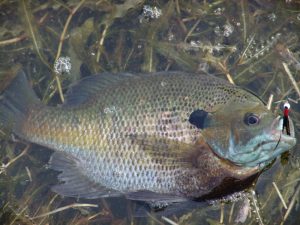
Photo: Kentucky Department Fish and Wildlife
Bluegill in the shallows doing their reproductive dance brings some of the fastest fishing found. “Bluegill are close to spawning and definitely willing to strike bait suspended under a bobber,” Baker said. “I’ve been to several of our central Kentucky lakes recently and received good reports on the bluegill fishing. We manage the smaller state-owned lakes in our district for good panfish populations. Boltz Lake, Corinth Lake, Beaver Lake, Elmer Davis Lake and McNeely Lake are all fishing really well for panfish right now.”
Two of those lakes lie in Grant County, 92-acre Boltz Lake and 96-acre Corinth Lake, and both hold good bluegill populations. “Corinth rebounded from the shad eradication a while back and is doing well for bluegill,” Baker said. “We see them now up 8 ½ inches regularly. We are also seeing redear sunfish up to 10 inches in Corinth.” Redear sunfish are commonly called “shellcrackers” by anglers.
Baker said 158-acre Beaver Lake in Anderson County is full of 8-inch and longer bluegill. “Fish tight to cover and under the cedar trees for bluegill on Beaver Lake,” Baker said. “We also saw redear sunfish up to 12 inches at Beaver. They are out in the middle of coves on the mud flats.”
Elmer Davis Lake covers 149-acres in Owen County near Owenton. The lake is now refilling after a drawdown for repair work on the dam. Kentucky Fish and Wildlife conducted a shad eradication on the lake over the winter that Baker said will improve the bluegill and the redear sunfish populations in the lake over the coming years.
“Another good bluegill lake is McNeely Lake in Jefferson County,” Baker said. “It is right in the back yard of a lot of people in the Louisville area. McNeely also has a healthy population of redear sunfish.”
The smaller state-owned lakes offer excellent bank fishing for bluegill as do the 43 Fishing in Neighborhoods (FINs) lakes scattered throughout Kentucky.
If one has access to a boat, Kentucky Lake is arguably the best bluegill lake in Kentucky. The lake holds fantastic numbers of 6- to 8-inch fish with many larger specimens in the population.
Target the back reaches of coves in May on Kentucky Lake. Those with some flooded timber and an overhead canopy make the best spots. Look for freshly swept depressions in the bottom, indicating bluegill nests. You can catch bluegill all day long from spots like this on Kentucky Lake.
In addition to these lakes, farm ponds and subdivision lakes often hold good populations of bluegill. To check the bluegill population at a lake near you, check the annual Fishing Forecast.
Suspending a wiggling redworm impaled on a size 6 Aberdeen hook under a bobber still works extremely well for bluegill, as it has decade after decade. The rig will also fool any redear sunfish nearby.
Feather jigs tipped with a wax worm or a cricket suspended under a bobber also work well for bluegill. If bluegill get finicky, bottom fish a redworm impaled on an Aberdeen hook near weedbeds. You may also pick off a few redear sunfish with this presentation as well.
The bluegill are in the shallows spawning. For those who want to catch fish after fish, there is no comparison.
 Weather
Weather Traffic
Traffic @LouisvilleDispatch
@LouisvilleDispatch @LouisvilleDisp
@LouisvilleDisp Subscribe
Subscribe
